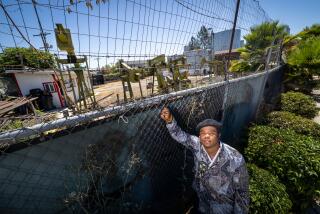After the Anger
- Share via
The students swirled around me in a tide of humanity that seemed to come suddenly out of nowhere.
They were all sizes, shapes and colors, and the noise level of their presence roughly equaled that of a rushing river.
I was standing near the campus area they call the Quad at North Hollywood High. It was the nutrition period, and a couple of thousand students had been let out to do whatever they do during nutrition.
The Quad is where fights broke out last week that escalated into chaos and got everyone wringing their hands and asking, “What’s happening to our kids?”
We’ve been asking that as long as I can remember, going back to when I was a kid, but maybe this time it’s different.
School board President Leticia Quezada has been asking the same thing, especially since she heard a group of 7-year-olds in a writing contest recite poetry about death, suicide and the city that burned down.
“Death, suicide?” she said, not believing what she’d heard. “You’d think at 7 they’d be talking about my friend Mary, the sky is blue and I went to the zoo. What’s happening here?”
I judged an essay contest that covered grades four to six, and an aching for serenity was the flip side of darkness. I could feel the pain of their longing, a desire so strong it escalated into fantasy, because daydreams are sometimes a safer place to be.
So what’s happening to our kids? I’ll tell you what’s happening to our kids. We are.
“Look around you,” North Hollywood High Principal Catherine Lum said to me the other day. “Kids are a microcosm of society. What’s going on here is what’s going on there.”
She’s a bright, outspoken woman with 28 years in education, years that have spanned the difference between fights that began over a candy bar and fights that begin over what color someone’s music is.
We had just come out of the main building to the Quad, which gave me a chance to look around at those who’d made the 11 o’clock news last week. They looked just like kids.
Whatever was bubbling around inside their heads didn’t show on the outside. They were talking, laughing, shoving, running, holding hands and doing all the other kinds of things high school students have always done.
And they looked very young.
We forget sometimes when we read about the hell teen-agers can cause that what we’re dealing with essentially are children.
But they’re children, Lum says, who have had to grow up fast:
“In addition to their normal teen-age anxieties, they’ve also got to worry about what’s happening to their neighborhoods and whether or not the old man has a job. All this time they’re expected to coexist. I ask you: Are we?”
Quezada sees a world in transition with blacks huddling in their corner, whites in theirs and Latinos in theirs.
“As they try to come out,” she says, “they’re harassed and no one is telling them it’s OK to come out, it’s OK to be colorblind.
“When we feel pressured, we go to Palm Springs,” Lum said, looking over the sea of kids that moved through the campus. “Where do they go?”
We’re all products of the world around us, and I don’t say that by way of excusing kids who maim and kill as a way of venting their frustrations.
My generation was born in a Depression, raised in a war, fought in a war, lived through a Cold War, protested another war and is growing old in God knows what.
We built bomb shelters, thought about moving to Chico, hollered “ban the bomb” and wondered if we’d all be blown to hell before we could achieve anything at all.
But somehow most of us managed to scramble along the paths to the future without being consumed by our own hatreds or marching off to Armageddon.
I’m not saying it’s any better or any worse now. When you’re in the middle of it, it’s always bad. I’m just saying that maybe the strong ones will emerge, maybe the bright ones will survive, and add a little something good to the melting pot.
Quezada talks about the dynamics of change that are causing hurricane winds in our lives, and Lum says that what matters now is what we do after the anger, when the rage has subsided.
They’re both right. We’re caught up in an age when people are no longer willing to remain in racial and cultural corners, and that’s the reality of a dream so many have held dear.
Now if we can get over the fear that new differences present, a sweetness will prevail we’ve never known before.
What’s wrong with our kids? Maybe they’re just dealing with the differences, and what awaits is something far better than anything we’ve got a right to expect.
More to Read
Sign up for Essential California
The most important California stories and recommendations in your inbox every morning.
You may occasionally receive promotional content from the Los Angeles Times.













